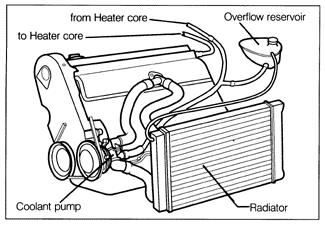Cooling SystemEven the most advanced engines lose some of their combustion energy as heat, which must be dissipated to prevent damage to the engine parts. Some heat is carried away in the exhaust, but much of it is absorbed by the valves, the pistons, and the rest of the combustion chamber. Most modern automobile engines are liquid-cooled, using a network of passages around the cylinders and combustion chambers, filled with circulating water-based coolant, to carry away heat. Circulation is provided by an engine-driven coolant pump, often called the water pump. The heat which the coolant absorbs from the hot engine is eventually dissipated to the surrounding atmosphere by the radiator at the front of the car. A smaller radiator-like heater core, located near the interior of the car, radiates heat to warm the passenger compartment. A basic cooling system layout, similar to that used on cars covered by this manual, is shown in Fig. 1-6.

Since some heat is necessary for the engine to run most efficiently, a thermostat in the cooling system restricts the flow of coolant through the radiator until the engine has reached normal operating temperature. For more information on the entire engine cooling system, see COOLING SYSTEM. |